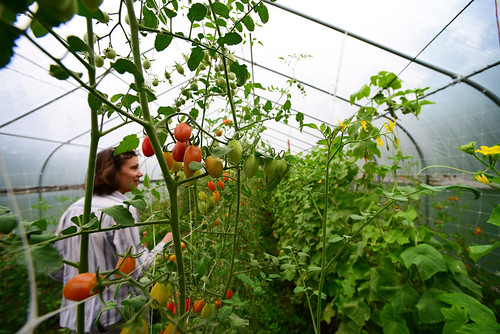
Every single student in Santa Fe County Schools in New Mexico received a juicy, locally-grown organic peach for lunch on the first day of school last year from Freshies Farm.
On only a little more than three acres of land, Christopher Bassett and Taylor Dale were able to grow the peaches for the schools and still find time to support two young children of their own.
For this young couple, their land and the food they grow is their life. After working on farms for 10 years in everywhere from California to Colorado, Bassett and Dale finally bought their own. They settled at Freshies Farm, a slice of a larger orchard near Velarde, N.M. near the Rio Grande.
When they arrived, the land was tightly packed with blackberry vines and peach and apple trees. But Bassett and Dale wanted to grow more than just fruit. They worked to clear just enough space to start growing other foods – tomatoes, cucumbers, asparagus, basil and oyster mushrooms.
In their five years on Freshies Farm, they have dedicated themselves to understanding how temperature, water and the health of the micro-organisms in the soil play a critical role in creating flavor.
They wait until their produce is perfectly ripe before handpicking it and selling it to the Santa Fe Farmer’s Market and in local restaurants.
“When I was training to be a chef, I realized that the flavor is really coming from the field,” Bassett said. “Everything you’re growing is a product of the soil, the sun and the micro-organisms.”
And their focus on flavor is apparent—their cherry tomatoes and blackberries have a taste as rich as their color.
In their quest for flavor, Thomas Gonzales, district conservationist from USDA’s Natural Resources Conservation Service has been at their side from the beginning.
Gonzales worked with Bassett and Dale using financial and technical assistance from NRCS to help diversify Freshies Farm and install a hoop house on their property in order to help grow tomatoes and other vegetables during cooler seasons to sell in local markets.
A hoop house, also called a seasonal high tunnel, acts like a greenhouse to help grow crops earlier in the spring and later into the fall without fear of frost.
With their hoop house and a separate mushroom growing operation, Bassett and Dale are now able to stay in business even in years where an early frost drastically cut their fruit production.
Bassett and Dale have also worked with Gonzales to put in other conservation measures that have helped them remain a growing and profitable farm including using native grasses to cover their orchard and increasing habitat for their orchard’s pollinators.
Two USDA strategic efforts helped make this conservation work possible. USDA’s StrikeForce for Rural Growth and Opportunity initiative addresses high-priority funding needs in rural communities in 16 states, including New Mexico. The Know Your Farmer, Know Your Food Initiative coordinates USDA’s efforts to support local and regional food systems.
“We hope that younger farmers will connect with the older generations to learn from them and keep these lands in agriculture when they’re gone,” Bassett said. “We really enjoy farming and having that connection with our customers. Every day, we get to live in a little strip of paradise.”

